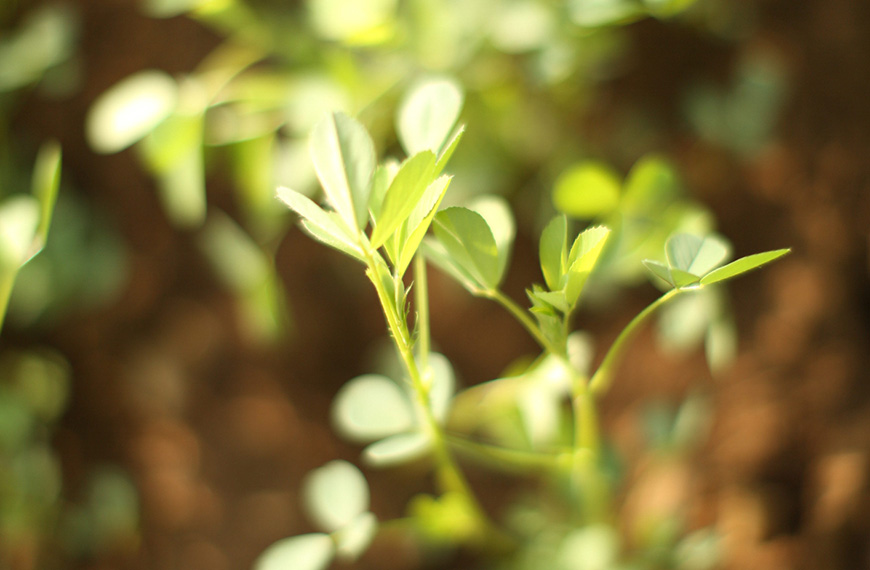5 Tips for Alfalfa Evaluation and Management

As an alfalfa grower, you know the importance of monitoring crop yields throughout the season. Getting out into the field with your agronomist at critical stages can help you optimally manage your crop for higher yield potential this year. Here are some tips to keep in mind when evaluating and managing your alfalfa.
1. Treat each alfalfa field as a unit. Avoid assessing just one or two alfalfa fields or just doing windshield scouting to make final decisions. Along with your agronomist, inspect and rank alfalfa fields individually as units of the entire farm. Review your management decisions or practices with your agronomist, and plan for the future. For example, your agronomist can advise you on specific soil nutrient, disease control and insect control needs along with cutting decisions.
2. Assess root health, winter damage. Dig representative roots and evaluate the alfalfa crowns. Healthy roots are solid, off-white in color and firm, with evidence of bud and early stem growth coming from the crowns. If roots have evidence of root rot damage or limited evidence of bud and stem development, it’s time to replace the stand.
3. Gauge stem density. To achieve 100 percent of yield potential, 55 alfalfa plant stems per square foot are needed. On a third-year alfalfa field, about five to seven plants will be required to produce a 55-stem density threshold. If the field has fewer than 40 to 55 stems per square foot, it’s time to replace the stand and replant that field with a different crop. The temptation is to leave the field in alfalfa production for one year too long.
4. Get ready for first, second and third cuts; anticipate the crop needs. If alfalfa plants don’t have enough nutrients to achieve growth, yield will be limited. Know the crop’s limitations before they can limit yield. Also pay attention to fungicide, insecticide and nutrient needs throughout the season.
Watch details; for example, test your soil for pH, potassium and phosphorous levels.
In northern climates, cutting alfalfa after about September 5 interferes with the plant’s ability to winterize itself. Growers in other regions need to adjust cutting schedules accordingly. The last cutting date is very important in determining whether alfalfa survives the winter. Work with your agronomist to create a cutting schedule that makes sense by setting up an ideal calendar plan.
So get out into the field with your agronomist to check on alfalfa health to help ensure a successful growing season. Keeping alfalfa crops on the offensive now will help keep you from having to play defense later.
CROPLAN and NutriSolutions are registered trademarks of Winfield Solutions, LLC.
HarvXtra is a registered trademark of Forage Genetics International, LLC.
© 2017 Winfield Solutions, LLC
1. Treat each alfalfa field as a unit. Avoid assessing just one or two alfalfa fields or just doing windshield scouting to make final decisions. Along with your agronomist, inspect and rank alfalfa fields individually as units of the entire farm. Review your management decisions or practices with your agronomist, and plan for the future. For example, your agronomist can advise you on specific soil nutrient, disease control and insect control needs along with cutting decisions.
2. Assess root health, winter damage. Dig representative roots and evaluate the alfalfa crowns. Healthy roots are solid, off-white in color and firm, with evidence of bud and early stem growth coming from the crowns. If roots have evidence of root rot damage or limited evidence of bud and stem development, it’s time to replace the stand.
3. Gauge stem density. To achieve 100 percent of yield potential, 55 alfalfa plant stems per square foot are needed. On a third-year alfalfa field, about five to seven plants will be required to produce a 55-stem density threshold. If the field has fewer than 40 to 55 stems per square foot, it’s time to replace the stand and replant that field with a different crop. The temptation is to leave the field in alfalfa production for one year too long.
4. Get ready for first, second and third cuts; anticipate the crop needs. If alfalfa plants don’t have enough nutrients to achieve growth, yield will be limited. Know the crop’s limitations before they can limit yield. Also pay attention to fungicide, insecticide and nutrient needs throughout the season.
Watch details; for example, test your soil for pH, potassium and phosphorous levels.
- pH: A neutral level between 6.8 and 7.1 is ideal.
- Potassium: This nutrient is often a yield-limiting nutrient for high-yield forage crops. 170 parts per million (ppm) is the minimum level.
- Phosphorous: 25 to 30 ppm is the minimum level.
- Sulfur and boron are also important to provide in sufficient quantities. Talk with your agronomist about using NutriSolutions® tissue testing to identify nutrient deficiencies.
In northern climates, cutting alfalfa after about September 5 interferes with the plant’s ability to winterize itself. Growers in other regions need to adjust cutting schedules accordingly. The last cutting date is very important in determining whether alfalfa survives the winter. Work with your agronomist to create a cutting schedule that makes sense by setting up an ideal calendar plan.
So get out into the field with your agronomist to check on alfalfa health to help ensure a successful growing season. Keeping alfalfa crops on the offensive now will help keep you from having to play defense later.
CROPLAN and NutriSolutions are registered trademarks of Winfield Solutions, LLC.
HarvXtra is a registered trademark of Forage Genetics International, LLC.
© 2017 Winfield Solutions, LLC

